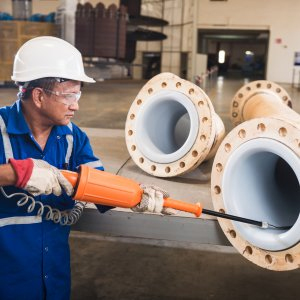
Roto-lining is a lining technique that allows a chemically modified polyethylene to form a bond with metals or other resins and enables vessels and pipes of a complex shape and limited access to be lined seamlessly and without difficulty, linings can be made significantly thicker than by other method. The bonded plastic can be used to line metal vessels, pipes, tanks or any other components that require corrosion protection and chemical resistance.
Muna Noor’s state of the art plant in Sohar Industrial area provides an internal coating facility for steel pipe and fabrications of all sort but particularly for the petrochemical industry.
Muna Noor have a specialist team of 30 technicians within the department and can perform roto-lining on objects up to 4 metres in length. The average turnaround of projects can be as fast as two weeks, dependant on the size of the project.
The method for lining involves three distinct stages. The first phase of the process involves shot-blasting the surface of the item to be lined after which the fitting or vessel is mounted to the moulding machine. A calculated quantity of polymer, which is in powder form, is placed in the fitting.
The fabrication is then heated in an oven whilst being rotated on two axis lining machine. Roto-lining is a tumbling and coating process, there is no centrifugal force of the material. During this time the temperature is accurately monitored and controlled to ensure the molten polymer’s viscosity is such that it never becomes liquid. When the essential temperature profile has been achieved and the polymer evenly coats the inside of the part the fabrication is gradually cooled and the lining is stabilised to minimise stresses in the lining. The process entails no force or shear to the material, roto-lined parts are lined completely seamless and weld free.
When cool the part is then removed from the machine and surfaces such as flange faces and O ring sealing areas are machined into the plastic.
To conclude the procedure, testing of the liner is required to ensure the continuity. Thickness tests are also carried out to ensure the required lining thickness has been achieved. Each part is fully tested to ensure completeness of the lining.
HDPE Liner Pipe
The transportation of corrosive fluids can inflict severe damage to carbon steel pipelines, causing leaks, premature pipeline failure, environmental damage, and lost production. The expected lifespan of a steel water injection pipeline in the oil industry is just seven years. As HDPE has an excellent resistance to corrosive chemicals it has been used successfully as plastic liners for many years, this method has a proven success to extend the life of the pipe and increase operating productivity of a pipeline.
The PE liner is extruded in the same way as normal PE pipe but at a specific outer diameter to exactly suit the pipe to be lined.
The PE liner diameter is reduced by being winched through a die directly into the pipe to be renovated thus reducing the diameter further and allowing the liner to enter the pipe to be lined. This smaller diameter is maintained by the winch wire tension. As soon as the liner has fully entered the pipe to be lined the winch is released and the liner begins to return to its original outside diameter and forms a tight fit with the host’s pipe internal diameter.
This tight fitting and continuous barrier between the bare steel and corrosive fluid protects the steel pipelines from a variety of chemicals in a broad temperature and pressure range. This method has proven to be an efficient and cost-effective maintenance technique.
To find out more about roto-lining manufacturing capabilities, please contact our team.


